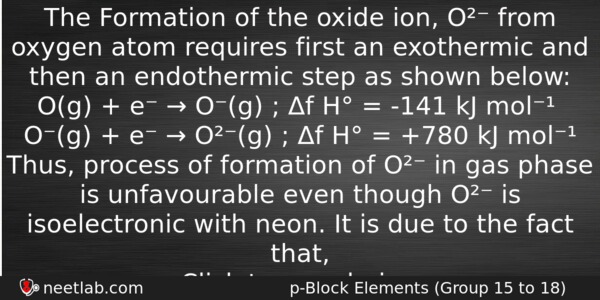| ⇦ | 
| ⇨ |
The Formation of the oxide ion, O²⁻ from oxygen atom requires first an exothermic and then an endothermic step as shown below:
O(g) + e⁻ → O⁻(g) ; Δf H° = -141 kJ mol⁻¹
O⁻(g) + e⁻ → O²⁻(g) ; Δf H° = +780 kJ mol⁻¹
Thus, process of formation of O²⁻ in gas phase is unfavourable even though O²⁻ is isoelectronic with neon. It is due to the fact that,
Options
(a) O⁻ ion has comparatively smaller size than oxygen atom
(b) oxygen is more electronegative
(c) addition of electron in oxygen results in larger size of the ion
(d) electron repulsion outweighs the stability gained by achieving noble gas configuration
Correct Answer:
electron repulsion outweighs the stability gained by achieving noble gas configuration
Explanation:
No explanation available. Be the first to write the explanation for this question by commenting below.
Related Questions: - Many transition metals and their compounds exhibit
- Isoprene is used for the preparation of
- Washing soda has the formula
- The reaction of an organic compound with ammonia followed by nitration
- If Na is heated in presence of air, it forms
Topics: P Block Elements in Group 15
(89)
Subject: Chemistry
(2512)
Important MCQs Based on Medical Entrance Examinations To Improve Your NEET Score
- Many transition metals and their compounds exhibit
- Isoprene is used for the preparation of
- Washing soda has the formula
- The reaction of an organic compound with ammonia followed by nitration
- If Na is heated in presence of air, it forms
Topics: P Block Elements in Group 15 (89)
Subject: Chemistry (2512)
Important MCQs Based on Medical Entrance Examinations To Improve Your NEET Score
18000+ students are using NEETLab to improve their score. What about you?
Solve Previous Year MCQs, Mock Tests, Topicwise Practice Tests, Identify Weak Topics, Formula Flash cards and much more is available in NEETLab Android App to improve your NEET score.
Share this page with your friends

Leave a Reply